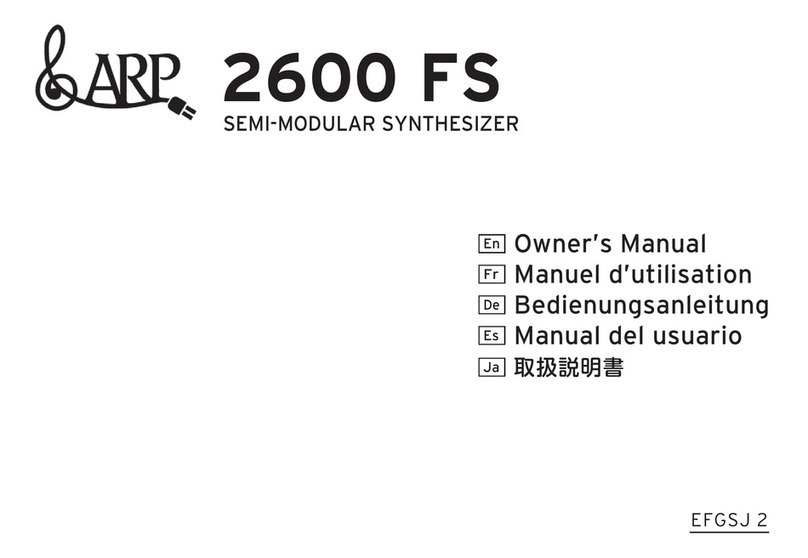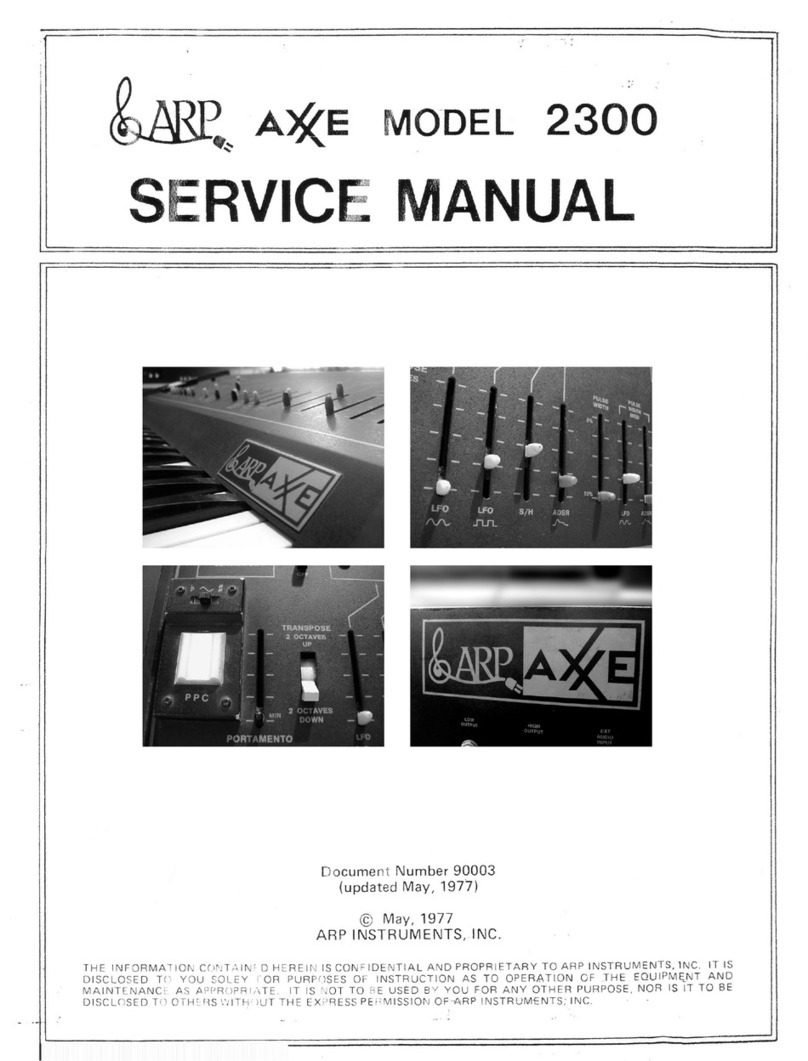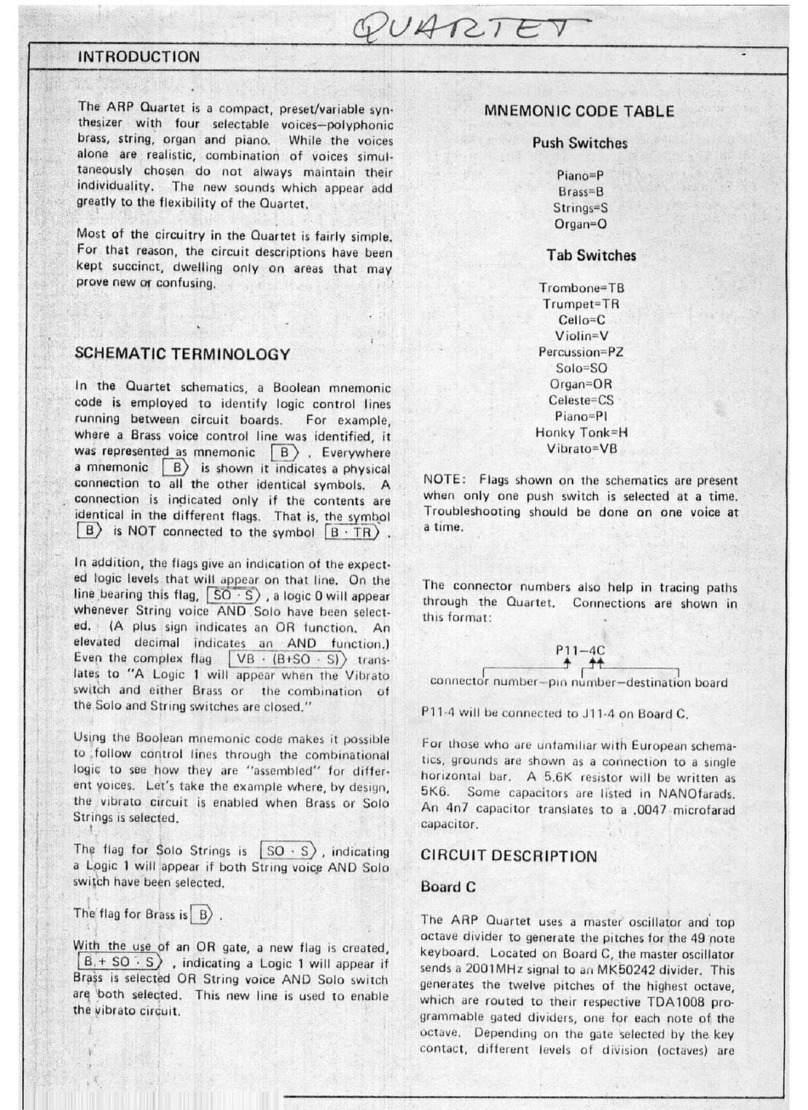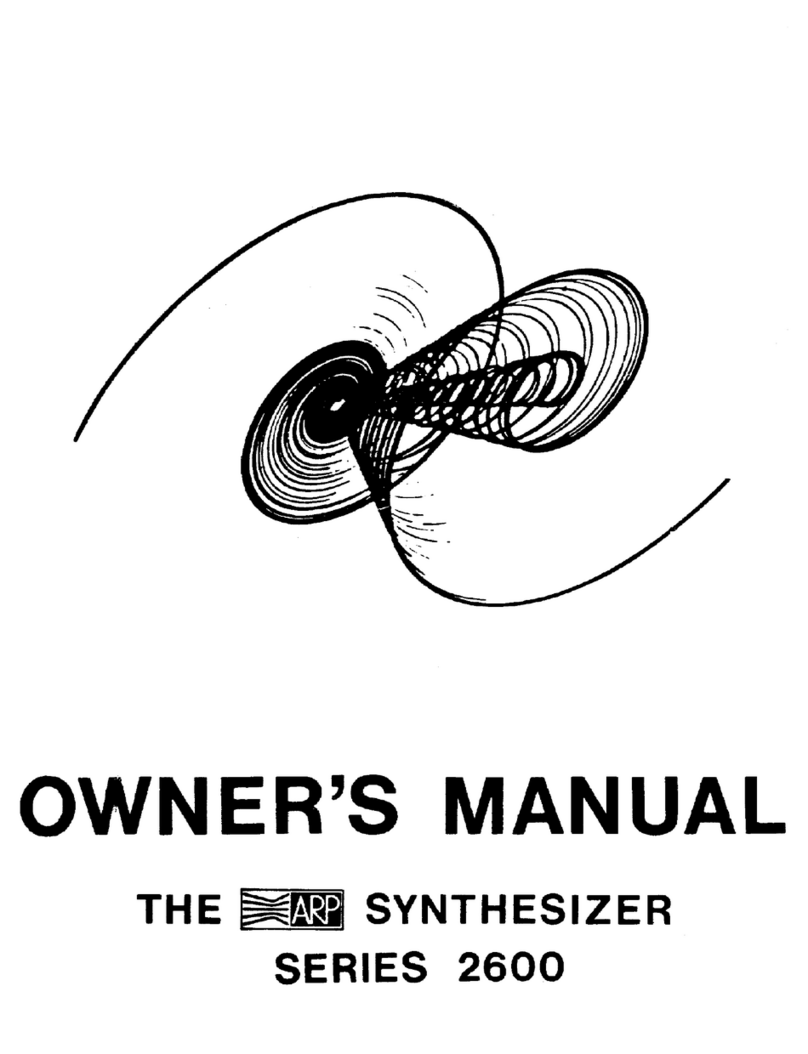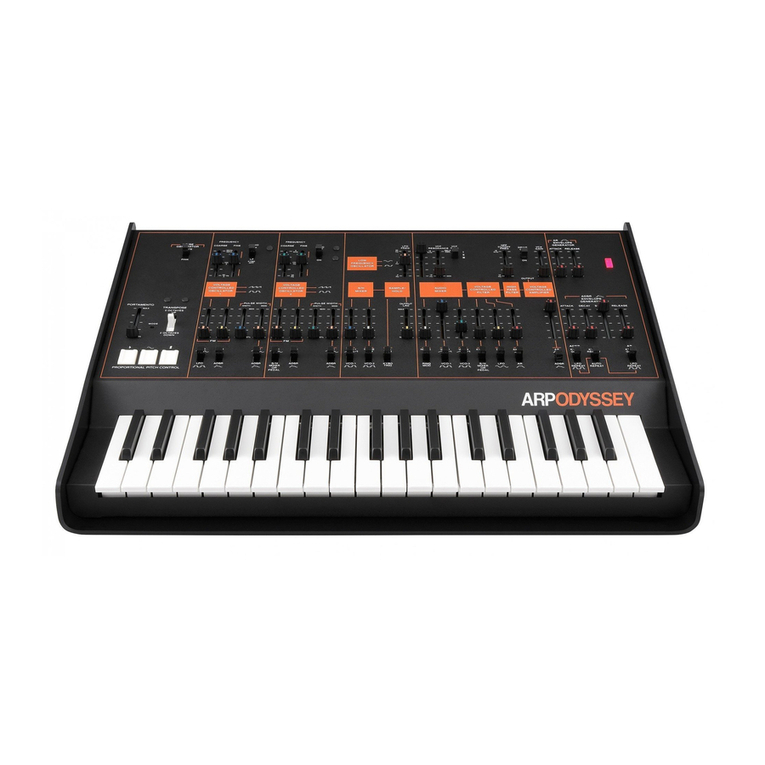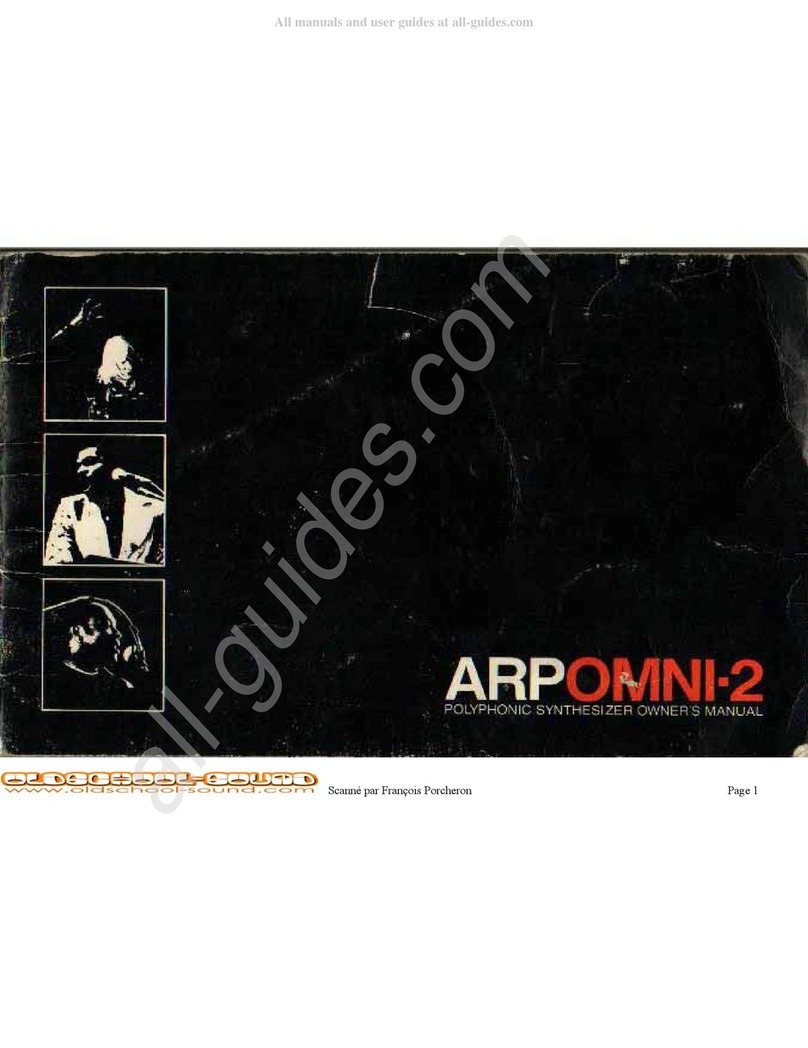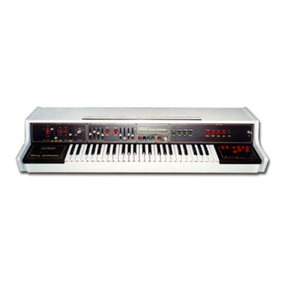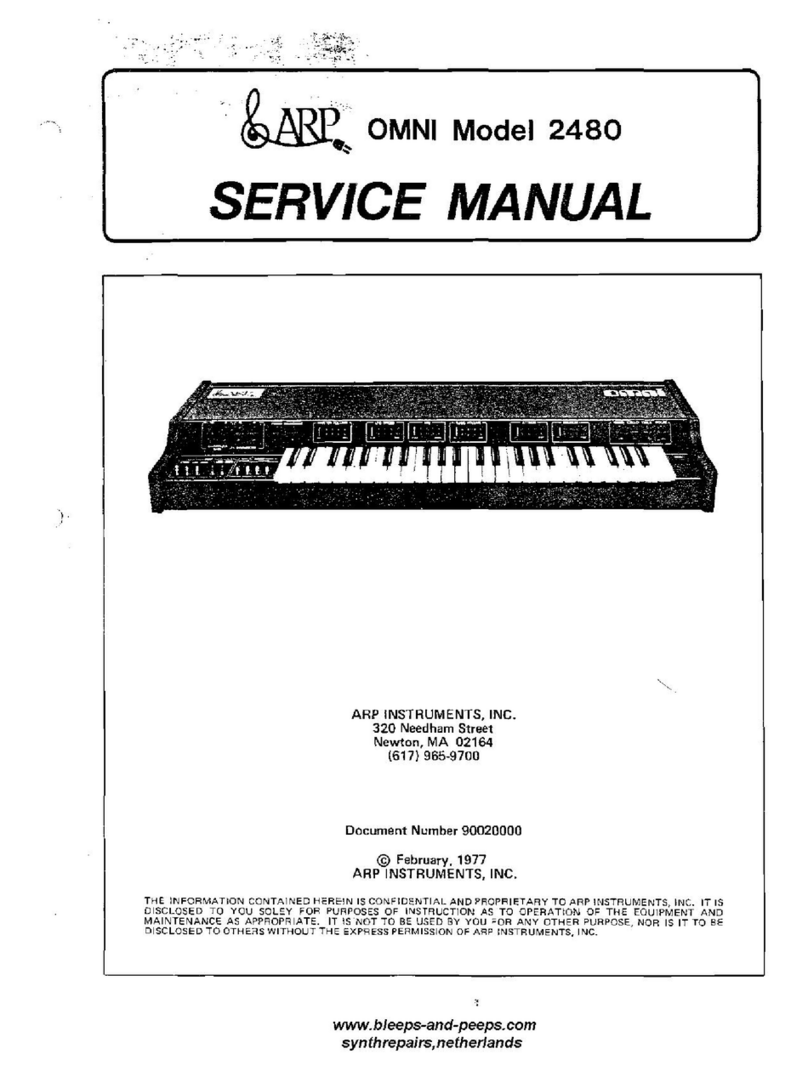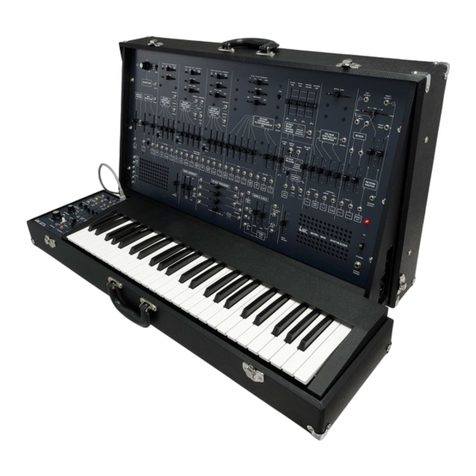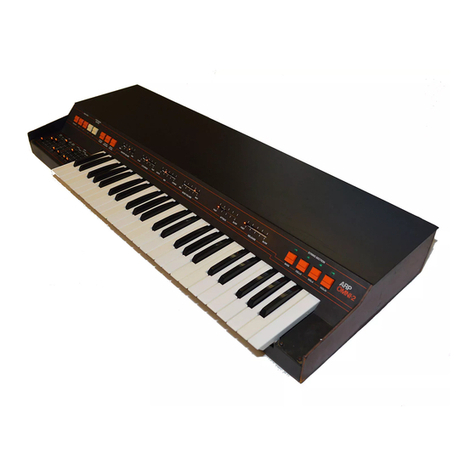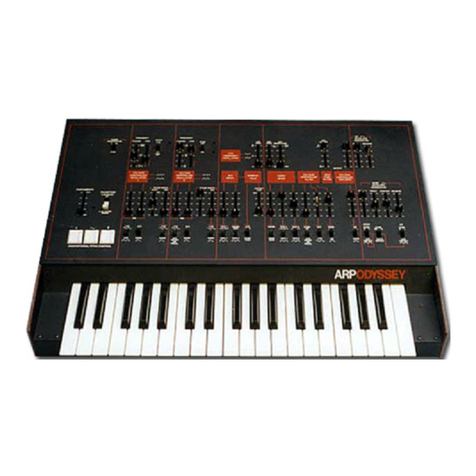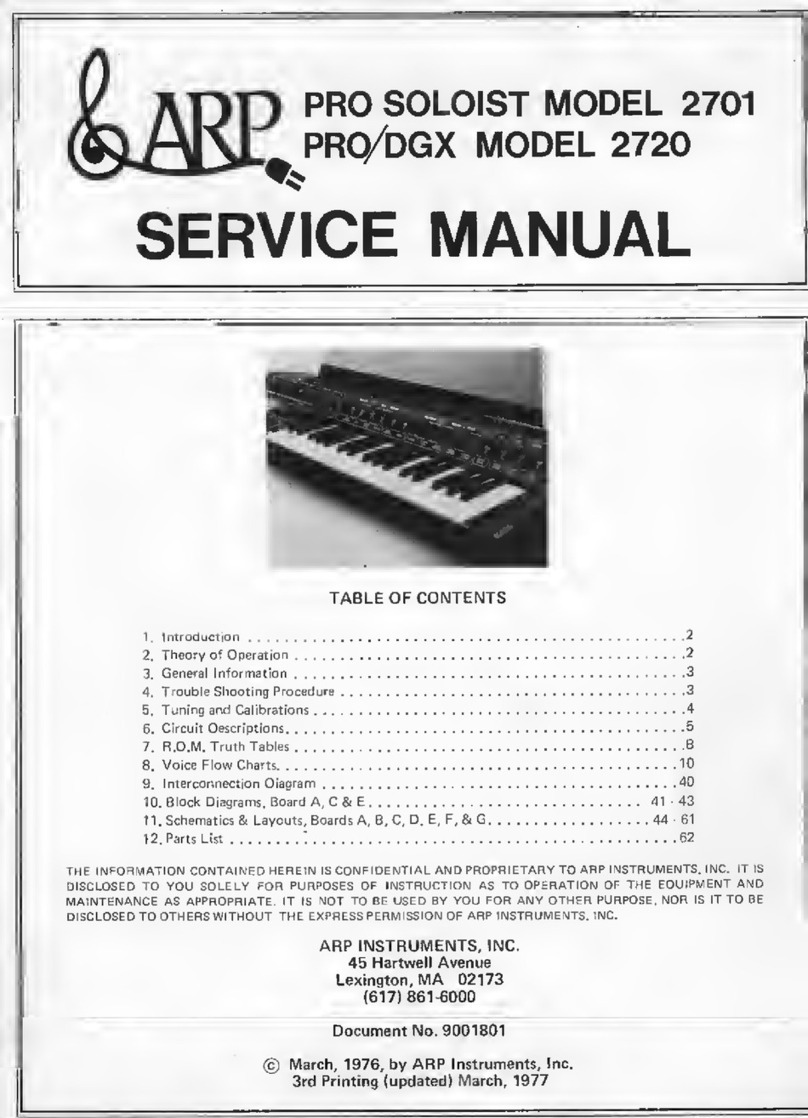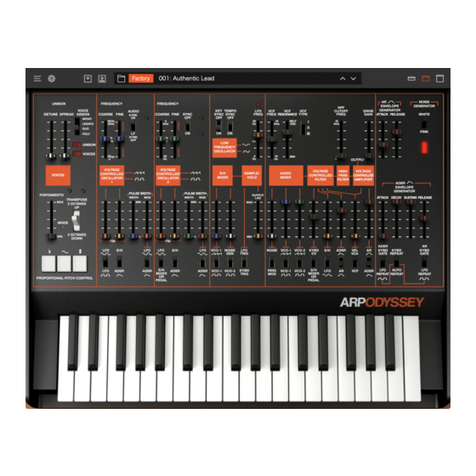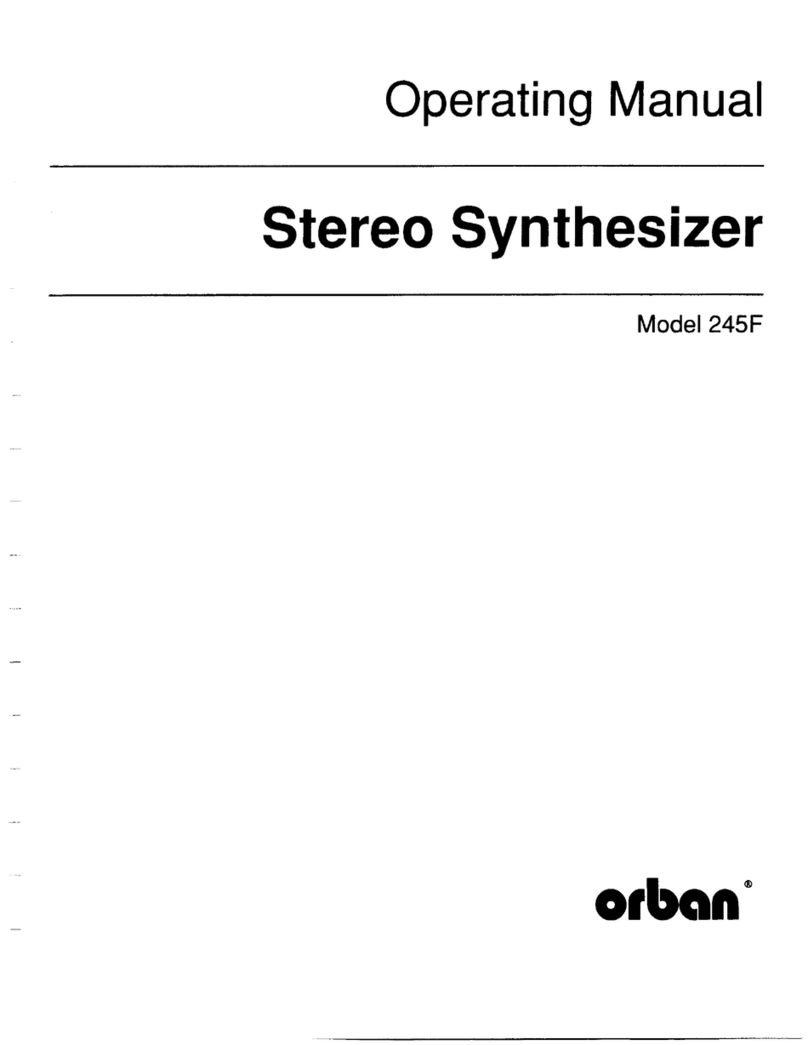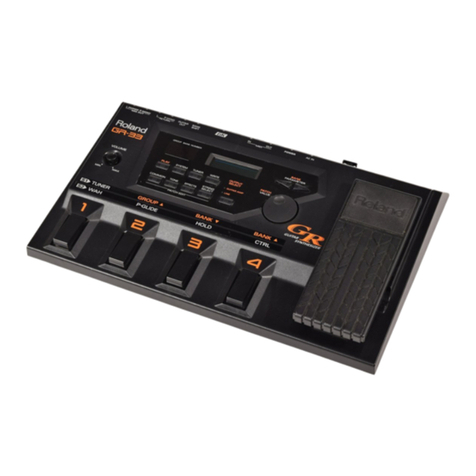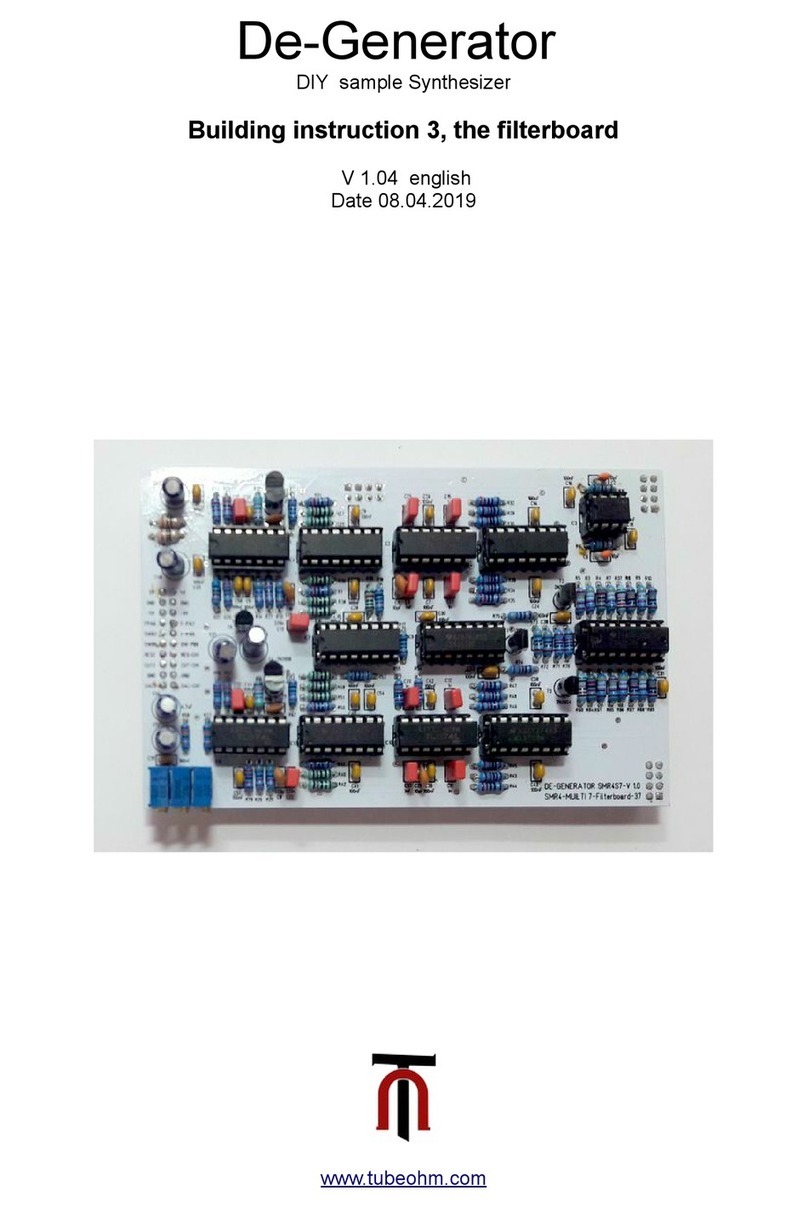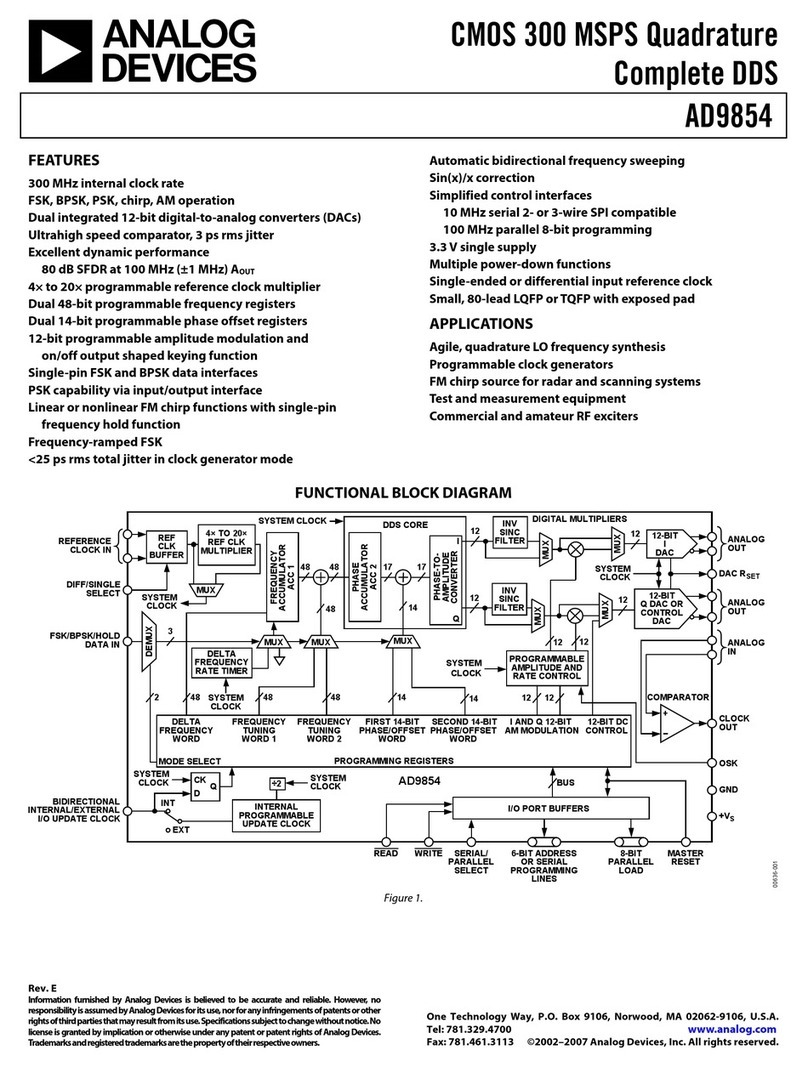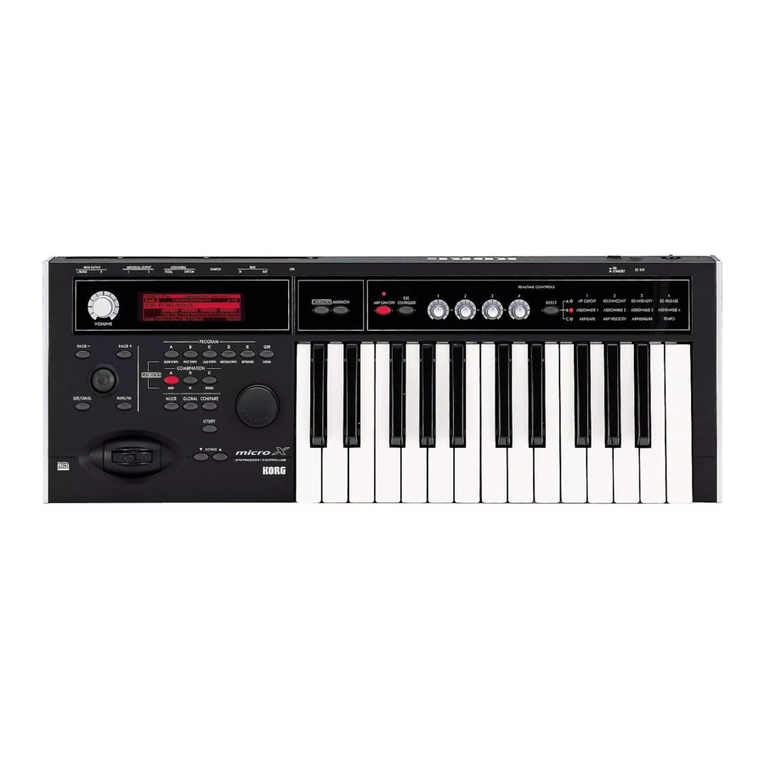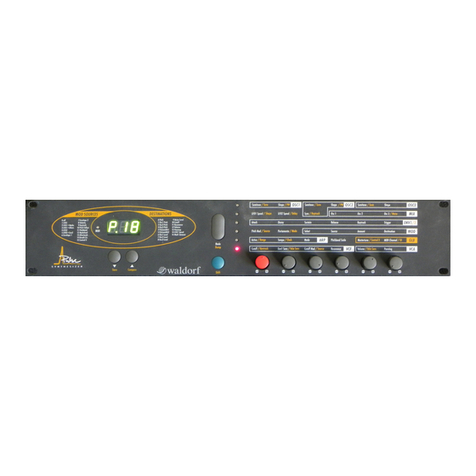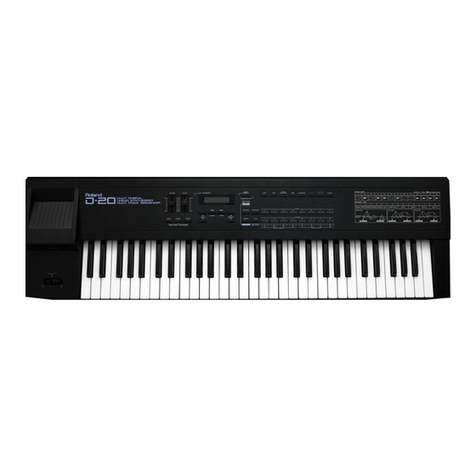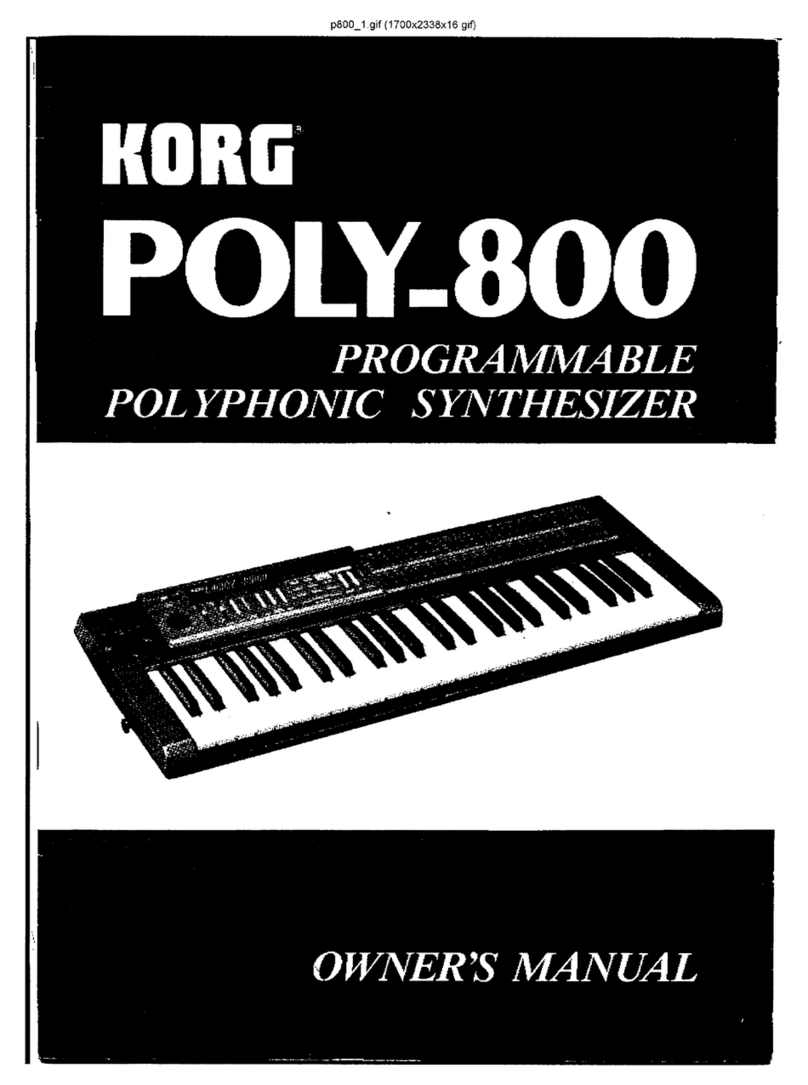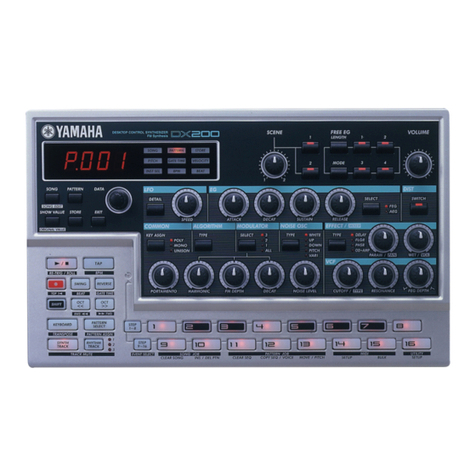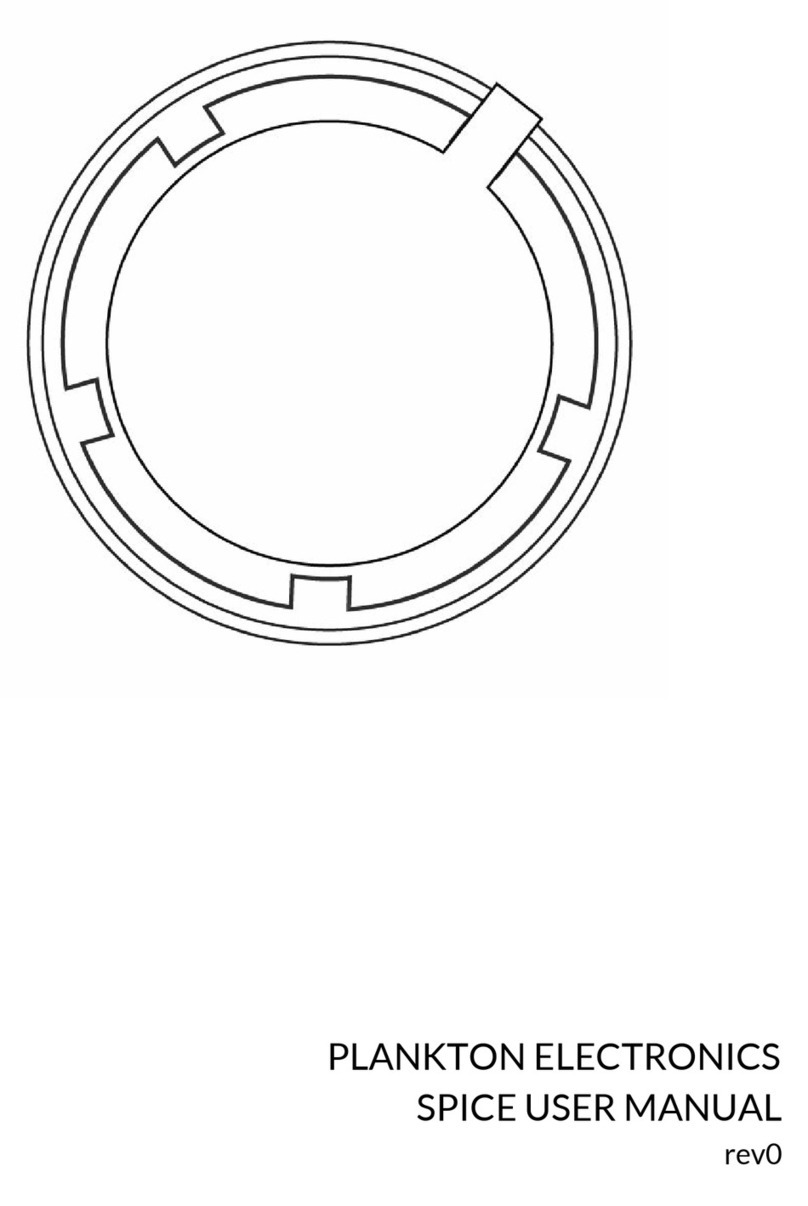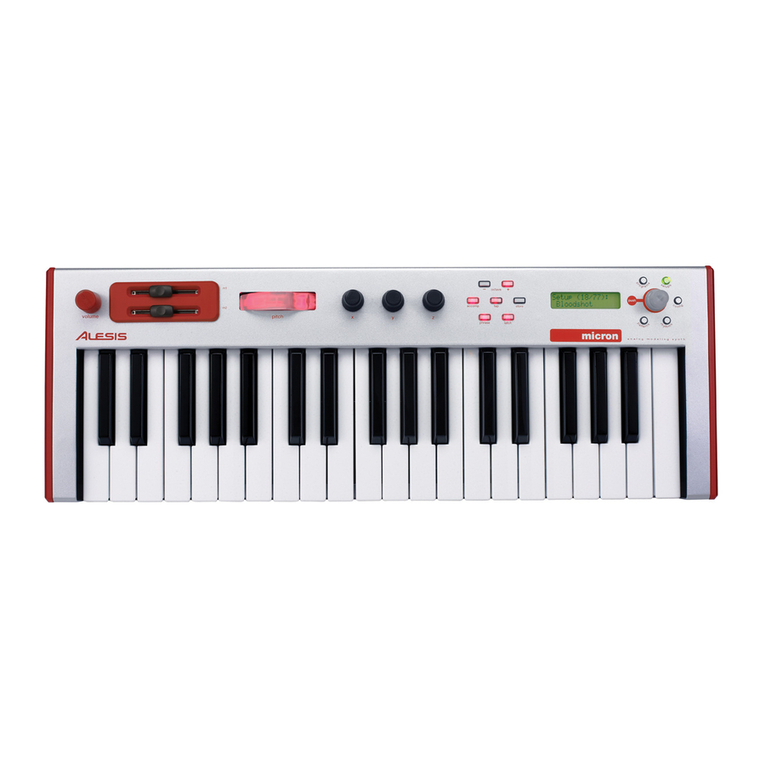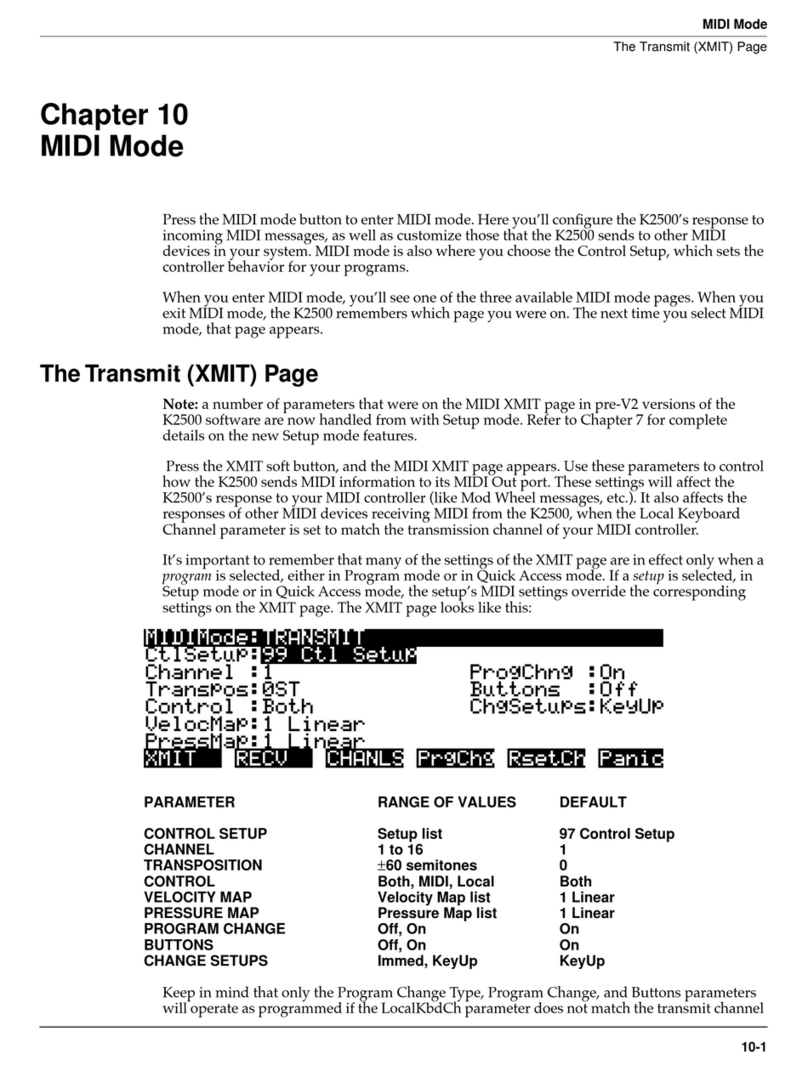ARP 2600 User manual

TH SYNTHESI
SERIES 2600

DO'S AND DON'TS
1.DO STUDY THE INSTRUCTION MANUAL CAREFULLY
AND OFTEN.
If you are extremely impatient to begin making music with your
2600, you can turn directly to section 5of the Manual. Use the two
panel charts from the Manual as guides. But only acareful study -of
the Instruction Manual will show you the infinite possibilities for
sound production that are contained in the 2600.
2. DO NOT ATTEMPT TO ADJUST THE RECESSED
CALIBRATION AND ALIGNMENT POINTS ON THE
FRONT PANEL.
until you are thoroughly familiar with your unit and with section 6
of the Manual. If you have any questions about calibration, or any
doubts about your ability to perform the alignment procedure
without assistance, contact your Factory-Authorized Service Center.
3. DO NOTtUNDER ANY CIRCUMSTANCES, OPEN UP THE
SYNTHESIZER OR IN ANY WAY MEDDLE WITH ITS
INSIDES.
This will immediately void your warranty.

OWNER'S MANUAL
THE ARP ELECTRONIC MUSIC
SYNTHESIZER
SERIES 2600
QnUSjriG 45 Kenneth Street, Newton Highlands, Massachusetts. 02161
(617) 969-0810. Cable: ARPSYN

Copyright 1971, by Tonus, Inc., Newton Highlands, Massachusetts, 02161. USA
All rights reserved. No part of this book may be used or
reproduced in any manner whatsoever without permission
from Tonus, Inc., except in the case of brief quotations
embodied in critical articles and reviews.
Printed in USA, February 1971
inc

II
INSTRUCTIONS FOR UNPACKING AND SETTING UP THE ARP 2600
1. Remove the main unit from its packing case and set it on a
firm support, preferably against awall or other backing.
2. Remove the 3604 keyboard unit from its case and set it in
front of the 2600. Two cable connectors are taped to the back of the
keyboard. Remove the tape and plug them into the sockets on either
side of the 2600 near the bottom.
3. Agrounded power cable is supplied with the 2600. Plug it
into the three-pin plug on the back of the main unit. The 2600 is
designed to operate from 110VAC sources. Do not attempt to use it
from aDC source.
4. Don't forget to TURN ON
^*v
%*m*
-**
"-'&-*
**tf
THE SYNTHESIZER. Often this
is the reason why you get no sound
out of it.
V
-fc a- -*i
hvrr
.->
.fc«- '^ •
4*AT*
*P%
-* .-^
3*.
Ej£*| 4&i «^r
.***'*"}*>
-* "
ww*e
m* r?K
,.** i_:"
.*#-
oooooo
jOOOOOOOOO
.'f •SYNTHESIZER
oo ooooooooooo
ooooooooooooo
oo ooooooooooo

TABLE OF CONTENTS
INSTANT INSTRUCTION
Setup Instruction and Important Warnings
CHAPTER 1
The Manual
CHAPTER 2
Electronic Sound Synthesis and Synthesizers
CHAPTER 3
The ARP 2600:A General Description
CHAPTER 4
The ARP 2600 Functions: Individually
CHAPTER 5
Using the ARP 2600:How to Put It All Together
CHAPTER 6
Calibration, Maintenance, Adjustment:Without Tears
—1
1
CHAPTER 7
Appendix
1
2
21
27
45
107
117

OWNER'S
MANUAL
2.0
ZA
Z.IJL
a. 13)
2.2
3.0 ^•C\
3.1
MM
1.0 THIS MANUAL is designed to serve two purposes.
1.01 THE Fl RST is to serve as an instruction book for the ARP
Model 2600 Electronic Audio Synthesizer.
1.02 THE SECOND is to serve as agenera! introduction to the terms,
concepts, and practices involved in electronic sound synthesis. -We
have designed it to serve this purpose because, first of all, there is at
present no such general introduction available, and second because the
ARP 2600 is specifically designed for those who have no prior experi-
ence either in using synthesizers or in thinking about sound in the
peculiar way that working with asynthesizer leads one to think.
1.1 THE PARAGRAPHS in this manual are numbered decimally to
correspond with the structure of topics. The most important general
headings are numbered with asingle digit; subtopics under each head-
ing will follow the digit with adecimal point and another digit, and
so on.
1.2 THE GENERAL HEADINGS and their numbers will be as follows.
1-THE MANUAL.
2-ELECTRONIC SOUND SYNTHESIS AND SYNTHESIZERS
3-THE ARP 2600. Ageneral description.
4-THE ARP 2600 FUNCTIONS. Individually.
5-USING THE ARP 2600. Or: how to put it all together.
6-CALIBRATION, MAINTENANCE, ADJUSTMENT. With-
out tears.
7-APPENDIX

9
2. TWO BASIC IDEAS ARE INVOLVED in a!! electronic music
synthesizers.
2.1 THE FIRST is that ACOUSTICAL WAVEFORMS CAN BE GEN-
ERATED AND MODIFIED PURELY BY ELECTRONIC MEANS.
2.1 1Banging on agarbage can lid generates ahorrible racket by
mechanical means. The racket is avery complicated sound; but no mat
ter how complicated it gets, it can be reproduced by asingle long and
complicated wiggle in aphonograph record. So can asymphony. From
acertain point of view all the sounds you've ever heard, ever will hear,
and ever could imagine, must be reducible to one (or at most two—one
for each ear) complicated wiggle of your eardrums.
2.1 11Edison's phonograph recorded by mechanical means the vibra-
tions he fed into it. The cylinder— and later the disc—stored them as
mechanical wiggles in agroove; on playback, running this groove past
aneedle made the needle wiggle, the needle made adiaphragm vibrate,
and the diaphragm passed it on to the air in the form of pressure vibra-
tions, and the air transmitted the sound waves to somebody's ears.
2.1
1
2Nobody has done it that way for quite awhile now. Today, a
microphone turns sound waves into electrical signals. In other words,
rapid and periodic fluctuations in air pressure are transformed into
rapid and periodic fluctuations in some electrical phenomenon—usualiy
avoltage. In this form the wave can be electrically amplified, equalized,
filtered, and subjected to various other indignities beforebeing sent to
arecording lathe that turns it back again into amechanical waveform in
agroove. Likewise, when the record is played, the stylus wiggles the way
it did in Edison's player, but its vibrations are immediately turned into
electrical signals. They don't become mechanical again until they reach
the loudspeaker.
2.12 IN ALL THIS, THE ONLY THING THAT DOESN'T CHANGE
IS THE SHAPE OF THE WAVE, i.e. THE WAVEFORM.
2.1 21 Suppose you bang an A-440 tuning fork on the corner of the
table. In 1/440th of asecond, then, the fork makes one complete vibra-
tion back and forth: .*bOL0M+>
vosi&ori cifr reef-
forth
;440-sec

3
fcuninc
2.122 if you had an exceedingly precise barometer around, it would
register during that same 1/440th of asecond, avariation in air
pressure: fc ^-^ 1kXtyHttf
UaO 5CC
average air pressure
tower
2.123 And anearby microphone connected to avoltmeter would
cause the pointer to swing: ptotfwc
titgaM^o
2.124 The same microphone passing its changing voltages on to an
amplifier, and the amplifier feeding its output to aloudspeaker, would
make the loudspeaker cone move back and forth:
back.
440 S*C brkh
to 2.1 21 ,is what'we began
...which you will see, by referring bac
with.
2.1241 We have used an extremely simple waveform for these exam-
ples; but remember that the process of translating waveforms we have
just outlined holds for any waveform whatsoever. In our graphs, the
only change from one example to the next has been in the meaning of
the vertical dimension of the graph; the horizontal dimension always
represents some period of time, while the vertical one changes from
representing physical position (the "back and forth" of the tuning fork
or the loudspeaker cone) to aphysical quantin (air pressure) to an elec-
trical quantity (positive or negative voltage). But the waveform is
unchanged.
2.125 Take another look at what we said in 2.123 and ask yourself
what the voltmeter would do if instead of being connected to the
microphone it were connected to some kind of electrical circuit that
could generate smoothly changing voltages at the rate of 440 times
each second. The pointer would swing positive and then negative like
this: •ipositive
440 sec TVtgatwe

4
2.126 And the same generating circuit hooked up to the amplifier
hooked up to the speaker would cause the same back-and-forth
movement as in 2.124: g..
bacK
^o s«o -fortW
...which amounts to getting the sound of atuning fork without hav-
ing atuning fork. Or, by the same principle, the sound of somebody
banging on agarbage can lid without either agarbage can lid or some-
body to bang on it. Or any sound at all: if you can generate the right
waveform electronically, then you can generate the sound.
2.127 The generators we talked about in 2.1 25 are not imaginary;
the\ exist, and they are called OSCILLATORS, and every synthesizer
has at least afew of them; areally big synthesizer might have several
dozen. So do electronic organs.
2.13 IF THE SHAPE OF THE WAVEFORM IS MODIFIED, SO IS
THE SOUND, and vice versa. Take this for the time being as an iron-
clad law; there are exceptions but they don't matter just now.
2.1 31 Wrapping an old army blanket around the garbage can lid muf-
fles the sound. Carrying it, wrapped or unwrapped, into atiled bath-
room while you're banging on it changes the sound again; and so on.
Anything you can do mechanically to modify the sound is going to show
pas amodification in the pattern of air pressure variations and there-
fore in the pattern of the changing voltages produced by-the microphone.
Turn the can lid into ashoebox and kick it across the room—a different
waveform. Turn it into akettledrum—another waveform. Spread rubber
cement over the drumhead—another waveform. Fill it with water—for
every pint, another waveform; not by much, maybe, but still different.
2.1 32 By the same principle, any modification in an electrical wave-
form will modify the sound it makes through an amplifier and loud-
speaker. The tone controls on aphonograph change the electrical
waveforms that pass through them; changing stops on an electronic
organ or drawbars on aHammond changes the electrical waveform
produced; and EVERY SINGLE CONTROL ON ASYNTHESIZER
has some effect on an electrical waveform.
u

5
Amplitude K* peafc.~fe_p»k.
^\yx£
Ampiftu<t€ Zv jpe*fc~t»-pB****
V\i
Amplitude 3v ptaK-tD-nca^
Ampl'itu<ie 4-v peaic^to -pe-^c
2.14 THE TWO SIMPLEST RELATIONSHIPS BETWEEN WAVE-
FORM-CHANGES AND SOUND-CHANGES are these:
2.141 Increasing the AMPLITUDE of an audio waveform increases
the VOLUME of the sound it makes. (But it might make no sound at
all— the amplifier might be turned off or the loudspeaker disconnected.
The point of this joke is to remind you that electrical vibrations and
sound waves are not, after all, the same kind of activity; there is no
sound inside electronic organs, or synthesizers either. Sound doesn't
enter into the picture at all until the rapidly fluctuating voltages which
the organ or synthesizer generates are amplified and fed to aloud-
speaker.) (YOU are interested only in the sounds—but the synthesizer
doesn't know that.)
2.141 1The AMPLITUDE of awaveform is the amount of maximum
deviation from its "center". In aloudspeaker this "center" is the posi-
tion of the loudspeaker cone at rest; in an electrical circuit h"might be
acondition of zero voltage. The amplitude of aloudspeaker cone's
motion would be measured in inches or more likely in fractions of an
inch back and forth. The amplitude of afluctuating or alternating vol-
tage would be measured in volts positive and negative. Thus avoltage
waveform that reached apeak of +1 Vand then of —1 Vwould have
an amplitude of 2V"peak-to-peak".
2.1412 You'll save yourself alot of confusion by thinking of AMPLI-
TUDE only in connection with waveforms and of VOLUME only in
2v connection with sounds. For example: because there are no sounds
inside asynthesizer (see 2.1 41 ), there cannot logically be any volume
controls; but there are agreat many amplitude controls. The point of
our putting so much emphasis on this distinction will become clearer
as you read on.
2.142 Increasing the FREQUENCY of an audio waveform increases
the PITCH of the sound it makes. But it is important here, just as with
AMPLITUDE and VOLUME, to keep the two notions distinct.
FREQUENCY is acharacteristic of PHYSICAL VIBRATIONS (whether

6
mechanical, electrical, or otherwise), but PITCH is apeculiar charac-
teristic of THE WAY HUMAN BEINGS PERCEIVE physical vibrations
between approximately 20Hz and 20KHz. And of course the whole
i
point of human perception anyway is to register and take note of
changes in one's surroundings. So achange in an audio frequency reg-
isters as achange in pitch, but frequency and pitch are not the same.
2.1421 For example: every pitch is produced by some frequency,
but many frequencies produce no sense of pitch at all—because they're
not audio frequencies. Middle Con apiano corresponds with afre-
quency of about 261 cycles per second—but afrequency of 2.61 cycles
per second corresponds to no pitch at all—it is far below audibility.
2.14211 Here is some useful terminology. Some kinds of vibration
have arepeating pattern; JWV
and if they do they are called PERIODIC. One segment of aperiodic
vibration, from any point in its waveform to the beginning of its
repetition, is aCYCLE. The length of one cycle (usually stated in sec-
onds or in fractions of asecond) is the PERIOD of the waveform; but
the number of cycles occurring in agiven length of time is the FRE-
QUENCY of the vibration. There is an international standard unit of
frequency: it is the HERTZ (abbreviated as "Hz") and it is defined as
ONE CYCLE PER SECOND. As usual, the prefix "Kilo-" means "one
thousand" and so avibration or oscillation of one thousand cycles per
second will be spoken of as "One KiloHertz" or "1 KHz".
2.14212 NOT ALL WAVEFORMS are PERIODIC. Some waveforms
happen only once; and some waveforms are so complicated that your
chances of finding any kind of repetition are nil regardless of what
frequency you look for. In this case the waveform as awhole will show
no particular repeating pattern but only an apparently random motion.
For whatever reason, awaveform that does not demonstrate any re-
peating patterns is called APERIODIC.
t.isec f
.1
period s.#050
r^ O50 ^20Hj
.tscc
period- JOZS
f^;
«p
025 40 H:
periods Of2.5"
t
fr«e^-i- =80ttz
AperioAc vi&vehrm&

7
X
"Timbre" is the
subjective quality
of atone which
enables the listen-
er to distinguish
between it and
other tones which
may have the same
pitch or loudness,
(e.g. trumpets and
clarinets produce
sounds of differ-
ent timbres.
)
2.1421 3We will use these terms throughout the rest of this manual.
Frequencies of less than 1Hz will generally be referred to by their period
to save you the labor of, say, translating ".05Hz" into "one cycle every
20 seconds".
2.15 CHANGES IN THE AMPLITUDE OR FREQUENCY OF A
PERIODIC WAVEFORM ARE, INDEED, SO COMMON, AND THEIR
RELATIONSHIP TO PERCEIVED SOUND SO CLEAR, THAT THEY
ARE NOT COMMONLY THOUGHT OF AS INVOLVING CHANGES
IN THE SHAPE OF AWAVEFORM AT ALL.
2.151 From now on we will follow this convention. Changing the
frequency or amplitude of awave will not count as a change in its shape.
2.1 51 1There is amore subtle reason than mere convenience for this
practice. Graphically, this waveform
can become this waveform
by amere change of coordinates; and likewise for turning this
waveform into this one #.-
But no amount of graphical transformation will turn something like this
into this ;no change in mere amplitude or frequency or
both or change in units of measurement. (The latter is what we mean
by a"change in coordinates".)
2.152 CHANGES IN THE SHAPE of an audio waveform are generally
associated with CHANGES IN THE TONE QUALITY, or TIMBRE*
of the sound produced. (See 2.131). Since human perception has limits,
there are possible changes in the shape of awaveform that might not
be perceived by even the most practiced ear; but anything that is
perceived as achange in timbre must be reflected in the waveform
being perceived.
2.1521 Summarizing 2.141, 2.142, and 2.152 gives us these approx-
imate relationships:

8
subjective changes in perceived... correspond to physical changes in the...
VOLUME
PITCH
TIMBRE or
TONE COLOR
AMPLITUDE
FREQUENCY
WAVESHAPE or
FREQUENCY-SPECTRUM
...of the perceived vibration.
This is worth remembering because, as we have emphasized elsewhere,
synthesizers work with the qualities listed in the right-hand column
for the sake of our perception of those listed in the left-hand column;
anyone who uses asynthesizer regularly must be able to translate eas-
ily from the language of volume, pitch, and timbre, to the language
of amplitude, frequency, and waveshapes. This section of the manual
is intended to get you started on this sort of translation back and forth
2.153 The OSCILLATORS in any synthesizer generate one or more of
these simple periodic waveforms: SINE ,SAWTOOTH
.SQUARE ,TRIANGLE ,and
PULSE
2.154 ANOISE GENERATOR produces an APERIODIC waveform
(see section 2.14212) of completely RANDOM pattern.
2.1 541 Arandom voltage has very interesting properties. You can
think of it statistically as awaveform in which your chances of finding
any particular frequency are equal to your chances of finding any other
frequency. Strictly speaking this sort of awaveform is called WHITE
NOISE, by analogy with white light: it contains all frequencies just as
white light contains all colors.
2.1542 Human ears tend to give undue prominence (for reasons we
needn't go into here) to the higher frequencies in aWHITE NOISE sig-
nal, so that it sounds like steam escaping from aradiator. If awhite
noise signal is slightly FILTERED to produce anoise whose frequency
content SOUNDS MORE EQUAL TO HUMAN EARS, it is called
PINK NOISE. Pink noise sounds like NIAGARA FALLS.
2.1543 From the statistical point of view, what happens when white
#
noise is FILTERED is simply that the odds on finding any particular
frequency in the noise waveform become heavily weighted in favor of
some certain RANGE OF FREQUENCIES. This range is called the
BANDWIDTH of the filtered noise. Thus we can talk about wideband
HOl^S
••••••
PINK. N
(Si
t
ft
R£.F.u£v6i
•MO ^c
Rfcf.weve^

ie~710 ^
\
to
I
\
da/
9
tf
noise, narrowband noise, noise centered around 2KHz, and so on.
(See also 2.182)
2.155 Each of these waveforms, at audio frequencies, has its own char-
acteristic sound (see 2.13). We will not try to describe here the sound
of each waveform; that will come into your own experience in sections
4 and 5.
2.16 We will call any periodic waveform with abasic frequency between
20Hz and 20KHz an AUDIO WAVEFORM. Frequencies between these
two extremes are AUDIO FREQUENCIES. Higher frequencies are
ULTRA-SONIC and lower frequencies are SUB-SONIC, or simply LOW.
2.161 Our reason for calling some frequencies "audio*1is of course
simply that only vibrations in this range can produce SOUNDS. If we
draw a line and put "1 Hz" in the center of it, and let the two ends run
off to Infinity, and let every half-inch or so represent amultiplication
by 1or division by 10, then we get agraph
#COl mo\ ,| 1Hz- 10
*II*\i
)0'
{
IO D* IO5lOfc 10 IC?
\
Cl KHz) f- \f
(1 MHz) \\
in which the range of human hearing is
AUDt&LE RjVm£>£.
2CM2-Z Z&KHZ.
\i
pate* fa.%c dcty&kv&\e
2.162 OF COURSE YOU CAN HEAR THINGS HAPPENING AT
LOWER FREQUENCIES than 20 Hz. BUT YOU HEAR THEM AS
SEPARATE AND REPEATING SOUNDS, not as continuing tones or
noises.
2.1621 Your heart is beating, let us say, 60 times per minute. (This is
rather low for apulse rate but keeps the numbers simple.} That's the
same as saying it beats once every second and so we can say it beats at
aFREQUENCY of 1Hz. Let's draw agraph:
NNow imagine your pulse gradually increasing to 120 per minute, or
2Hz:

iO
And now to something like 20Hz (that's 1200 times aminute—alot
of adrenalin):
_JLjI_J_jU
And finally to say 60Hz:
Somewhere just above 20Hz you would lose your sense of individual
EVENTS happening very rapidly. Instead you would begin to hear a
very low PITCH gradually rising with the rising frequency of your
heartbeat. And the opposite would happen if your heart began to slow
down again—first adescending PITCH, then the gradually growing
sense of no pitch at all but rather of separate and countable EVENTS.
2.163 ASYNTHESIZER CAN GENERATE AND MODIFY both
AUDIO-FREQUENCIES (i.e. PITCHES and NOISE) and LOW-FRE-
QUENCIES (i.e. EVENTS).
2.1 631 You ma> think of an event that happens only once as having
an infinitely low frequency—like picking aguitar string once for all
eternity, or beating adrum just once and then travelling on .
2.1632 Playing anote on apiano and repeating it at some regular
interval produces aseries of EVENTS at alow frequency. The events
have acertain PITCH because each event is the occurrence of an
AUDIO-FREQUENCY vibration. Here's agraph of everything that
happens:
and here's agraph of the LOW-FREQUENCY waveform involved
and the audio-frequency that produces the pitch looks, all by itself,
like this
2.1 633 Note that in any graph of an event or aseries of events such
as the first one in 2.1 631 above, you can derive the SHAPE of the
LOW-FREQUENCY WAVEFORM involved by simply connecting the

n
highest points on the higher-frequency waveform.
2.1634 Thus we come to the very important notion that EVENTS
have SHAPES. And the SHAPE of any event is the SHAPE OF THE
LOW-FREQUENCY WAVEFORM that can "produce" the event. Thus,
for example, playing astaccato tune on an organ would produce a
series of pitches
and aseries of events of this shape
Playing the same tune on aguitar would produce, perhaps, the same
pitches Vr
but the events would have adifferent shape altogether.
2.164 THE SHAPE of an EVENT is called its ENVELOPE or CONTOUR.
In the example given above, we could say that the notes 'played on the
organ have adifferent ENVELOPE from the same notes 'played on the guitar
2.1641 Here are some possible envelopes:
banjo distant thunder
piano note fortissimo piano note soft and staccato
organ note organ note taped and played backward
banjo taped and played backwards .
Chinese gong

12 Aec^y
attack'
2.17 Any low-frequency waveform may be used to produce events
and to give them ashape. But usually asynthesizer will have one or
more devices designed specifically to generate low-frequency wave-
shapes suitable for giving events ashape. These are called ENVELOPE
GENERATORS or ENVELOPE TRANSIENT GENERATORS. Their
output is APERIODIC (see 2.1422); instead of appearing over and
over again spontaneously it appears only when the envelope generator
isTRIGGERED.
2.18 OTHER CIRCUITRY in any synthesizer MODIFIES waveforms
by MIXING them, FILTERING them, or MODULATING them.
2.181 Two waveforms can be added together by simply adding their
values at every instant. This is easier to show than to talk about:
cltu^c
3IOND-> OT-
-16Y
This \y added to this 'makes this .Once ^
4-1 i^V^f
they are mixed it's practically impossible, except in simple cases, to
untangle them again.
2.181 1IT MAY SEEM ODD that when you have mixed together say
the sound of aviolin and the sound of apiano (or any two or more
instruments) it is all but impossible to separate them again. But re- iIAAA /
member what is going on: in electrical terms, aparticular sound is not
represented simply by "a voltage'' but bv aPATTERN of voltage fluc-
tuations. So when two or more signals are electronically mixed into
one, two or more patterns have been added together to form amore
complicated pattern. And the problem of separating them is not a
simple problem of dividing avoltage into little voltages, but the
much more complicated one of separating patterns, i.e. wave-
forms, out of one complicated pattern.
It is as if you were to copy apage of this manual onto one
line by writing each line directly on top of the preceding line:
line by iwi^&iungv'eaehdiDepiyreqlkgaD^
all the fetters would be there, but the copy would be illegible. Your
ears, from long practice perhaps, generally have no difficulty in
recognizing familiar patterns in the 24-hour-a-day waveform the
world presents to them; no other instrument can even begin to ap-
proach the ease with which, say, you disentangle the voice of afriend
A-
in acrowd from all the other voices in the crowd. This is aproblem in
+1 ^mMK1"

13
0/s^tuTeP.£ P
p-tuTF P^ED
L»wpa'>1. Pu X%&»
**sae~ H^rtPA4^
2CHi-
PATTERN RECOGNITION, and has for many years been the subject
of intense research by computer-program designers. But the best they
have done so far falls considerably short of what your ears and brain
do all the time.
2.1812 In very simple cases, frequencies may be removed from a
waveform by FILTERING (see 2.182 following), but afilter circuit
is aperfect idiot: it knows nothing of what the frequencies it is
blocking or boosting mean, and can do nothing to separate two sounds
of the same pitch. The scratch filter in astereo amplifier cuts out some
of the noise from adirty or scratched record; but halso removes any
musical sound that fails in the same frequency range as the scratches.
On agood pair of speakers this is quite audible as aloss of sparkle and
airiness in the recording—aslight muffling of the sound.
2.1 81 3So one way of making more complicated waveforms out of
simple ones is by MIXING simple ones together. This is also sometimes
called additive synthesis. The drawbars of aHammond work by addi-
tive synthesis.
2.182 In acomplex waveform representing many frequencies simul-
taneously, some frequencies may be weakened, strengthened, or
removed almost entirely by FILTERING. The treble and bass con-
trols on astereo amplifier are simple filters that boost or cut high and
low audio frequencies respectively. Afilter may operate over abroad
or narrow range of frequencies; it may pass all signals up acertain fre-
quency, in which case it is called aLOW-PASS filter; it may pass only
frequencies above acertain frequency, in which case it is called a
HIGH-PASS filter. Or it may pass only anarrow band of frequencies;
then it is aBAND-PASS filter. If it does just the opposite, i.e. passes
ie^Hz. all frequencies except acertain band of frequencies, it is aBAND-
JOKHz
fte€
QANSDP
+3J8
Fu~rtepN
ScC ^X.
*'**M*—4S*#3£
REJECT, or NOTCH filter.
2.1821 Simplifying acomplex sound by filtering is called subtractive
v
^fr^Hx. synthesis.
2.183 To MODULATE awaveform is to change it systematically,
following the pattern of another waveform. If the change is in frequency,
l0Kt#z then the result is FREQUENCY MODULATION (FM); if the change is
in amplitude, then the result is AMPLITUDE MODULATION (AM).
Other kinds of modulation exist and will be discussed later.

14
2,1 831 Here is asimple example of frequency modulation. Suppose
we begin with asimple oscillation, say asquare wave at afrequency of
100Hz:
Now, at the rate of 25Hz, let's alternately double and halve again the
frequency of this square wave:
If we draw agraph in which up means higher frequency and down means
lower frequency, and graph the changes in frequency of our 100Hz
square wave, it looks like this:
-5eye!
Alook at the first and last graphs, and at their "result" in the second
graph, shows what we mean if we say that we have FREQUENCY-
MODULATED A100Hz SQUARE WAVE by A25 Hz SQUARE WAVE.
If, instead of shifting suddenly up and suddenly down again, we start from
100Hz and moved gradually up to say 200Hz and then started suddenly
again from 100Hz, agraph of the changes in frequency would look like
this:
4leu£ft h
and in this case we would say we had FREQUENCY^MODULATED A
100Hz SQUARE WAVE WITH A25Hz SAWTOOTH.
2.1832 AMPLITUDE MODULATION, on the other hand, of a100Hz
square wave by a25Hz square wave would produce something like
1y
Other manuals for 2600
3
Table of contents
Other ARP Synthesizer manuals
